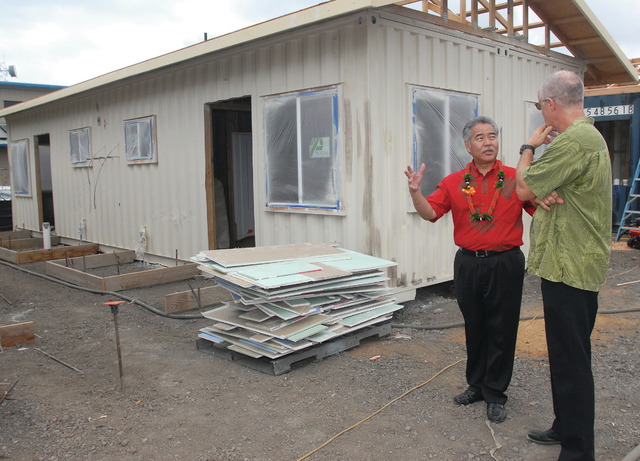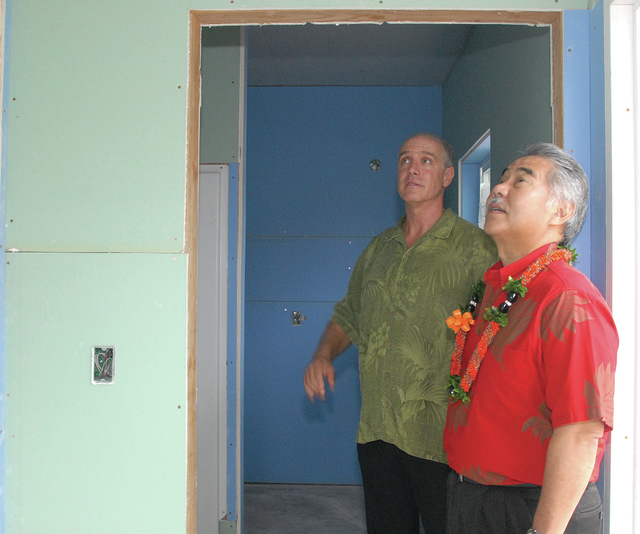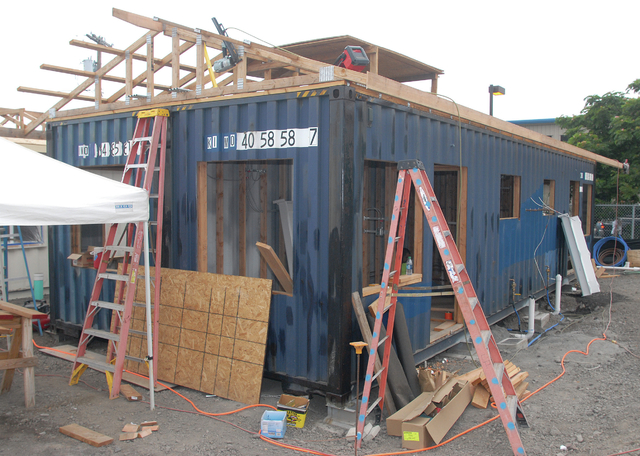KAILUA-KONA — Gov. David Ige visited the micro-housing project in the Kona Old Industrial Area on Wednesday, nearly one year after he issued an emergency proclamation for Hawaii’s homelessness crisis.
The project was the county’s response to the governor’s call for more to be done throughout the islands, particularly in regard to permanent housing solutions, which the state prioritized instead of emergency shelters in part because of a shift in federal funding favoring the Housing First model.
Ige was pleased with the results as he surveyed the site just off Pawai Place in a lot adjacent to the Friendly Place, calling it the final portion of the three-piece solution to the puzzle of homelessness, of which the area containing the site provides a snapshot.
“There is an emergency shelter to get people stabilized and do the intake, services — which we know the homeless need, either mental health or substance abuse or both — and then permanent housing. This is kind of the collection,” Ige said. “We want to be able to take someone off the street, get them into a shelter, provide services and get them into permanent housing. It’s all the components we know are important.”
Ige also was proud of the speed with which the micro-housing project was contrived, planned and initiated.
Ken Van Bergen, assistant housing administrator at the Hawaii County Office of Housing and Community Development, said the blessing of the site will take place before Thanksgiving and tenants likely will move in by the first week of December.
“I’m ecstatic that we are here and seem to be on schedule to be able to finish this facility in November, about a year after starting,” Ige said. “And when you talk with people in this business, that’s record time. Obviously, I think we all would want things to happen faster, but as we get into these projects, we really understand what all the challenges are in providing housing — especially permanent housing.”
Some of those challenges were anticipated while others popped up along the way. Ige mentioned sewer and water connections being a universal difficulty. Access to transportation for work and other services also is a consideration, he explained.
And then there’s the money. The cost of the project, roughly $2.4 million, ended up being double the amount for which the initial funding plan called.
The project is being funded with public money.
Ige said with time and experience, future endeavors might be more cost-effective. The micro-housing unit project is similar to another initiative at Sand Island on Oahu, where shipping containers are being repurposed to serve as shelters.
“We are getting better,” Ige said. “It’s trying to find out what works. I think these micro-housing units provide a clean, individual space. We’re trying to be flexible. What works here in West Hawaii might not work in East Hawaii or on Oahu.”
The county has shown some flexibility by adjusting plans as the project has progressed. It was slated to produce 32 units, which was still the plan as the calendar flipped to summer months. In recent weeks, however, the decision was made to reduce that number to 23 units.
“We designed the project in-house to save time and money, and to take advantage of the emergency proclamation,” Van Bergen said. “After doing the grade and getting on-site, we decided to reduce units to make it more of an appropriate fit.”
Some in the community found the cost to be inflated and burdensome considering the number of beds the initiative will create. The price of production comes out to a little more than $104,000 per unit.
“Kona needs a shelter, not more 140- to 180-square-foot apartments that cost $700 per square foot to build when we’re getting the containers for next to nothing,” said former Kona Brewing Co. CEO Mattson Davis, who is set to serve in the same role with Hawaii Shelters Inc. — a nonprofit with the goal of building a 300-bed shelter in West Hawaii. “It’s ridiculous.”
Overly expensive or not, there is undoubtedly a high demand for permanent housing in Kailua-Kona, which for now will cater exclusively to the chronically homeless.
There were about 100 applicants for residence in the 23 units, Van Bergen said. Several of them engaged in the application and interview process Wednesday at a pavilion in the Old Kona Airport State Recreation Area.
“They are going to be nice,” said Van Bergen, adding that Section 8 vouchers will be attached to a number of the units. “They’re going to be very clean and safe, and unlike an emergency shelter, they’re long term. So, the people who move in here have the opportunity, if they follow the rules and pay their rent, to stay here for a long time.”
A building on-site will be used for offices and as a place for residents to connect with services.
“It’s very important when you deal with this kind of population that you have services attached because that’s what they really need for the long term,” Van Bergen said.
Email Max Dible at mdible@westhawaiitoday.com.











